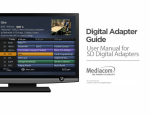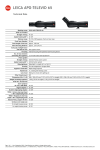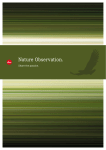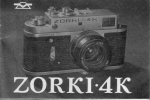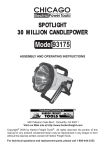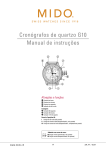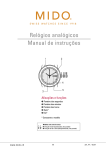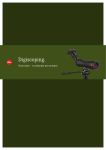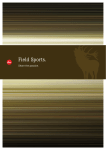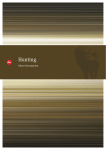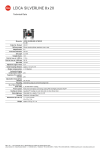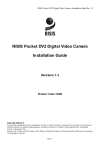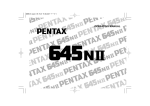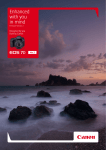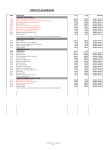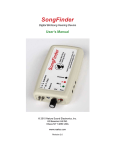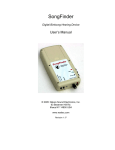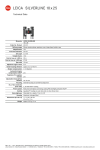Download Digiscoping. - Leica Camera Україна
Transcript
Digiscoping. Observe – and capture forever. All Species of Birds are Different ... Contents ... each is unique and special in its own way. Digiscoping History Digiscoping kit Digiscoping systems 04 06 08 10 Components Spotting scopes Eyepieces Tripod and tripod head Cameras and adapters 12 14 22 24 28 Hints and tips Good to know 36 38 More products Leica Sport Optics 48 Whether you’re a serious birdwatcher or simply a lover of the glory of nature – anyone who wanders through fields, woods and meadows will be rewarded again and again with fascinating sights. With Leica optics, we offer you a unique opportunity to capture every single sight forever — even those that are far away — by com bining our modern spotting scopes with the latest in digital camera technology. The result is a digiscoping system in which all compo nents have been engineered to be in perfect harmony. A system that only one manufacturer in the world can offer with such outstanding quality: Leica. Delve into the wonderful world of digiscoping in the following pages. Discover flora and fauna with a brilliant optical system and look forward to breathtaking images. Your Leica Sport Optics Team 03 Our Products are much More than ... ... reliable companions; they are faithful friends and partners – often for a whole lifetime. They are made for people who wish to experience things in close-up that others can only vaguely perceive, far, far away. People who demand more, and who seek something truly special – and find it with us. DIGISCOPING We have been a manufacturer of premium binoculars and spotting scopes with superior optical systems and precision-engineered components for more than 100 years. And for almost as long, a manufacturer of cameras that continue to set new standards. By combining cameras and spotting scopes, we have now created a digiscoping system that is a precision tool for both field observation and photography. Cooper’s hawk It Began with a Spur-ofthe-Moment Idea ... ... and today, digiscoping has developed to such an extent that wildlife and nature observation is almost unimaginable without it. The story began in 1999. More or less by chance, wildlife watchers held up a compact digital camera to the eyepiece of a spotting scope and pressed the shutter. The result was not just good; it was astounding. And as soon as the first users posted their pictures on the Web, they took the birdwatching world by storm. A real alternative to heavy and bulky SLR cameras was found — and a new way of seeing and taking pictures was born. The following years have seen constant development of this technique. Today, the camera is no longer simply held up to the eyepiece, but attached professionally with an appropriately designed adapter. But the system’s functional capabilities are not decided by the adapter alone. What’s important is that all its components are designed and engineered for perfect mechanical and optical harmony. As they always are at Leica. We offer ideal digiscoping systems to satisfy all needs — comprising a high-performance spotting scope, a digital camera with a fast lens and an adapter that connects them, a rugged, steady tripod and a tripod head optimised especially for digiscoping. Observe the glory of nature and its flora and fauna as if at your fingertips, but from a safe and respectful distance. The image you have in view can then be captured and preserved forever — in your own, personal, creative photographic style. Waxwings 06 07 The Leica Digiscoping Kit. A Perfect Combination. LEICA X2 LEICA X1/X2 DIGISCOPING-ADAPTER LEICA EYEPIECE 25 x – 50 x WW ASPH. In its natural tundra habitat, the Snowy Owl rarely needs to seek cover and is therefore an excellent subject for digiscoping. Motionless and seemingly thoughtful, the owl sits on a small rock — and gives you the time you need to compose your shot and capture every detail in a pin-sharp image. LEICA APO-TELEVID 82 W Digiscoping today is not simply for spontaneously captured moments, it is also an important tool for precise identification and documentation. If you need to identify even the smallest differences, qualitatively superior equipment is vital. Leica offers you a complete digiscoping system from one brand. All the components are manufactured in a meticulous process from only the finest materials, to guarantee absolute dependability and enduring value. Leica cameras are compact, elegant in design and intuitive to use and, at the same time, make absolutely no compromises in their mechanical and optical quality. Tripod Head LEICA DH 1 Tripod LEICA TRICA 1 The benefits at a glance L eica is the world’s only premium manufacturer to provide a complete professional system from one single brand a ll components are perfectly matched intuitive handling o utstanding imaging results optical brilliance, excellent colour fidelity, maximum contrast 08 09 Digiscoping Systems. Perfectly Prepared for the Decisive Moment. LEICA APO-TELEVID 65 and 65 W/82 and 82 W with LEICA EYEPIECE 25 x – 50 x WW ASPH. LEICA X2 LEICA X1/X2 DIGISCOPING-ADAPTER LEICA V-LUX 40 LEICA UNIVERSAL-DIGITAL-ADAPTER 3 LEICA PHOTO-ADAPTER for analogue and digital SLR 10 LEICA TRICA 1 with LEICA DH 1 11 Components The Most Wonderful Moments ... ... are those you always hope to capture. And yet it’s natural to want to capture them forever. Imposing, almost majestic, the raptor circles above your head. You wait impatiently. The panorama is breath taking. The light is ideal. When on earth will the bird land on the rock over there? When can you press the shutter release to capture that once-in-a-lifetime shot? The digiscoping system from Leica is the ideal starting point for first-class digiscoping results. Leica is the only premium optical systems manufacturer to offer everything you need for digiscoping from one brand. This means that all components are engineered for perfect mechanical and optical harmony. This also ensures it is fantastically easy to use and enables you to capture images of incomparable quality. Discover the joy of Leica digiscoping and preserve breathtaking moments for all time. 12 13 APO-Televid Spotting Scopes. Bright and Brilliant. CUTAWAY VIEW LEICA APO-TELEVID 82 W The APO-Televid 65 and the APO-Televid 82 from Leica both fulfil the most stringent demands expected from a high-quality spotting scope. Each model is particularly compact and offers outstanding close-focus performance. They are robustly engineered and also offer logical and intuitive handling, attractive design and impressive optical systems. The spotting scopes are made with an innovative fluoride-lens system that guarantees excellent colour fidelity, impressive sharpness and maximum contrast. The perfectly matched 25 x — 50 x WW ASPH. wide-angle eyepiece offers you a particularly wide field of view. The proven Leica dual-focus system features two different focusing ratios that allow fast and precise focusing at all magnification factors. The front section of the focusing wheel is for fine focusing, while the rear section is for general focusing on your target. The mechanism is ideal for intensifying your experience of viewing from long distances. Thanks to their rubber-armoured magnesium bodies, both scopes are exceptionally rugged and able to cope with even the most extreme weather conditions. The water and dirt repellent AquaDura® coating guarantees a constantly clear view, while the nitrogen-filled body reliably prevents fogging inside the optical system. 14 15 APO-Televid 65. Practical and Compact. Your gaze wanders upwards. There, looking back down at you, is a pair of glowing yellow eyes. Quickly, you get into position, moving your APO-Televid 65 to focus on the small owl. The wide face and round, white-spotted head of the Mountain Pygmy Owl are revealed in stunning detail. LEICA APO-TELEVID 65 The APO-Televid 65 features an innovative fluoride front lens that delivers images with excellent colour fidelity and clarity, particularly in daylight. The Leica dualfocus system with micro-focusing ensures fast, precise focusing. With an overall length of just 11.9 in/30 cm and a weight of only 39.4 oz/1,115 g, it is very portable, making it perfect for long field trips and when travelling. The magnesium body makes it extremely rugged, and rubber armouring ensures effective absorption of external impact to guarantee almost silent viewing. You can look forward to first-class images – regardless of whether your subject is close to you or far away. LEICA APO-TELEVID 65 W The benefits at a glance s tate-of-the-art fluoride-lens optical system for perfect colour fidelity and maximum contrast e xtremely handy and compact in size particularly short close-focusing limit of only 9.5 ft/2.9 m w ith water and dirt repellent AquaDura® lens coating r ugged and silent in use, thanks to a rubber-armoured magnesium body L eica dual-focus system for fast and precise focusing 16 17 APO-Televid 82. First-class Imaging. As if sprinkled with snowflakes, the bird’s brown plumage is spotted with white feathers. A Mountain Pygmy Owl sits in the silent snow-covered landscape. He looks at you directly, as if he can see you just as clearly as you can see him. It’s quite possible: he has his superb eyesight, and you have your APO-Televid 82. LEICA APO-TELEVID 82 This spotting scope is tailor-made for highly demanding, professional-level digiscoping. The outstanding optical performance is reflected in an extremely vivid and brilliant image rendition across the entire field of view. Its fluoride lenses guarantee you maxi mum colour fidelity and contrast. The apochromatic optical system of the APO-Televid 82 includes modern fluoride glasses to ensure perfect optical performance. The inner optical system is additionally protected by an optically neutral covering lens. The large front-lens diameter of 82 mm delivers a richly detailed view and its enormous light-gathering performance enables viewing even in the most difficult lighting conditions. LEICA APO-TELEVID 82 W The benefits at a glance s tate-of-the-art fluoride-lens optical system for perfect colour fidelity and maximum contrast 82 mm lens diameter with excellent light-gathering performance for a brilliant view, even in failing light s hort close-focusing limit of 12.5 ft/3.8 m with water and dirt repellent AquaDura® lens coating rugged and silent in use, thanks to a rubber-armoured magnesium body Leica dual-focus system for fast and precise focusing 18 19 Technical Data. Spotting scope Leica APO-Televid 65 Leica APO-Televid 82 Order no: Straight viewing 40 127 40 119 Angled viewing (45°) 40 129 40 121 Package includes lens and bayonet caps lens and bayonet caps Front lens diameter 65 mm 82 mm Focal length approx. 17.3 in/440 mm approx. 17.3 in/440 mm Close focus range approx. 9.5 ft/2.9 m approx. 12.5 ft/3.8 m Exit pupil, twilight factor and field of view please refer to eyepiece table please refer to eyepiece table Focusing internal focusing with dual-focusing function internal focusing with dual-focusing function Lens coating HDC® multicoating and AquaDura® lens coating HDC® multicoating and AquaDura® lens coating Schmidt-Pechan prism system Schmidt-Pechan prism system Angled viewing (45°) Schmidt prism Schmidt prism Waterproof waterproof to 16.5 ft/5 m waterproof to 16.5 ft/5 m Body magnesium, nitrogen-filled magnesium, nitrogen-filled Prism system: Straight viewing Eyepiece attachment quick-release bayonet Tripod mount 1 Lens shade retractable, with sighting aid retractable, with sighting aid Front lens filter thread E67 E82 11.8 x 4.3 x 3.3 in/ 288 x108 x 83 mm 12.3 x 4.3 x 4.0 in/ 313 x108 x101 mm 11.9 x 4.3 x 3.3 in/ 302 x108 x 83 mm 12.9 x 4.3 x 4.0 in/ 328 x108 x101 mm Weight (without eyepiece): Straight viewing 39.4 oz/1,115 g 53.7 oz/1,520 g Angled viewing (45°) 39.6 oz/1,123 g 51.8 oz/1,469 g Accessories (for order no. refer to pages 84 – 85 in the comprehensive catalogue) Ever-ready cases Ever-ready cases Dimensions (L x H x D): Straight viewing Angled viewing (45°) ⁄4 in, rotating, with locking screw quick-release bayonet 1 ⁄4 in, rotating, with locking screw GREAT HORNED OWL 20 21 Eyepiece. Superior Field of View at all Magnification Factors. Quiet, with an alert gaze, he sits on the edge of the cliff. A buzzard hunting for food. Mesmerised, you watch it through your spotting scope. A quick look at the bird’s feet confirms your guess that it is indeed a Rough-legged Buzzard. The 25 x — 50 x WW ASPH. variable wide-angle eyepiece guarantees incomparable viewing quality across the entire field of view — without any limitations, and throughout the entire zoom range. And this with a subjective field of view of up to 74° at 50 x magnification. The bayonet system has an integrated, automatic eyepiece lock that attaches eyepieces quickly and securely to the spotting scope. The rubber-armoured functional components and practical rotating eyecups ensure excellent viewing comfort. Even when wearing gloves, the eyepiece can be precisely adjusted. LEICA EYEPIECE 25 x–50 x WW ASPH. The benefits at a glance 2 5 to 50 x magnification wide-angle field of view: 135 ft/41 m (25 x) to 92 ft/28 m (50 x) at 1,094 yards/1,000 m a spherical lenses ensure superior edge sharpness w aterproof to a depth of 16.5 ft/5 m e laborate nitrogen filling prevents fogging r otating eyecup with click-stop settings 22 23 Tripod and Tripod Head. A Safe and Steady Platform for Precise Photography. First you only hear its distinctive warning cry. Then you see its characteristically long legs. The Burrowing Owl is most active at dusk, but you’re lucky enough to see it hunting during the day – and you’re perfectly prepared to take a rare photo. A stable tripod is absolutely essential as a steady platform for shake-free viewing and digiscoping. The Trica 1 tripod is constructed from light and resilient carbon fibre, with a weight of just 4.6 lb/2.1 kg. Its maximum extended height is 68.9 in/ 175 cm. At the same time, it can be quickly set up and collapsed. The matching Leica DH 1 tripod head provides a stable support for the spotting scope and camera, offering flexible movement in all directions. A Leica balance plate is available as an optional accessory. This optimises weight distribution when a spotting scope is mounted on the tripod, and simultaneously guarantees shake-free viewing and precise photography. LEICA TRICA 1 with LEICA DH 1 Leica DH 1 t he fluid head can be locked in horizontal and vertical positions by lightly turning two locking knobs h ead tilt range from ± 90 °, loading capacity up to 8.8 lb/4 kg manual locking can be fully compensated by setting the correct friction: the spotting scope and the camera remain in the chosen position the extended panning arm allows easy, precise and steady movement of the complete digiscoping system w eight: 1.26 lb/570 g 24 Leica Trica 1 imensions: max. tripod d extension 68.9 in/175 cm, min. 15.0 in/38 cm, collapsed length 27.6 in/70 cm weight: 4.6 lb/2.1 kg only available in a set with the Leica DH 1 tripod head 25 Technical Data. Eyepiece Leica 25 x – 50 x WW ASPH. Order no. 41 021 Package includes eyepiece case, bayonet cap and eyepiece cap Exit pupil: APO-Televid 65 2.6 mm (25 x) to 1.3 mm (50 x) APO-Televid 82 3.3 mm (25 x) to 1.6 mm (50 x) Field of view at 1,000 m/yds 135 ft/41 m (25 x) to 92 ft/28 m (50 x) Subjective angle of view 57° (25 x) to 74° (50 x) Focal length 17.9 – 9 mm (17.9 ± 0.15 to 9 ± 0.1) Max. external diameter 2.3 in/59.5 mm Overall length 4.1 in/105 mm, without bayonet 3.4 in/87 mm Weight 15.3 oz/435 g Tripod Leica Trica 1 Order no. 42 223 Package includes Leica DH 1 tripod head Description carbon-fibre tripod Max. tripod extension 68.9 in/175 cm Max. extension with DH 1 73.0 in/185.5 cm Min. tripod height 15.0 in/38 cm Collapsed length 27.6 in/70 cm Weight 4.6 lb/2.1 kg Tripod head Leica DH 1 Description compact, lightweight, low-profile fluid head in Soulid 238, fluid damping, quick-change plate with 1⁄4" screw mount Panning range 360° Tilt range ± 90° Weight 1.26 lb/570 g Height 3.3 in/8.5 cm Maximum loading weight 8.8 lb/4 kg great grey owl 26 27 Leica X2. Superior Performance — “Made in Germany”. You have spotted a Ruby-Crowned Kinglet. It hops about excitedly, searching for insects and spiders. Easily recognisable due to the characteristic patch of red displayed on the male’s head — but only when he’s excited. You can capture the sight of this tiny bird forever with your Leica X2. For its compact size, the camera features an impressively large, professional CMOS image sensor that, in combination with its fast Leica Elmarit 24 mm f/2.8 ASPH. lens, guarantees images of superior brilliance. Low image noise ensures that image quality remains high, even long into the twilight hours. The intuitive handling of the Leica X2 is ideal for both instant shots and meticulously arranged compositions, and enables split-second changes between automatic and manual control. Even new users will soon discover the sheer pleasure of photography with a Leica X2. The benefits at a glance f ixed focal length intuitive handling frame-filling view from 35 — 50 x eyepiecemagnification f ast Elmarit 24 mm f/2.8 ASPH. lens large, professional, APS-C CMOS image sensor permits high ISO settings e xtremely simple access to manual functions s elf-timer for shake-free exposures large, high-contrast, 2.7" LCD screen c an be easily mounted on spotting scopes with the Leica X1/X2 Digiscoping-Adapter 28 LEICA X2 with X1/X2 DIGISCOPING-ADAPTER Leica X1/X2 Digiscoping-Adapter recisely engineered to connect p scope and camera small and light secure, accurate connection extremely easy to use 29 Leica V-Lux 40. Always ready for those special moments. A moment ago, they were swimming calmly on the lake; now they suddenly take to the air. You excitedly follow the rapid flight of the pair of Northern Pintails. And press the shutter release of your V-Lux 40. Thanks to a continuous-shooting rate of 10 fps at full resolution, and a spectacular 60 fps in high-speed mode, you will effortlessly capture the pair. The enormous zoom range of the Leica DC Vario-Elmar 4.3 — 86 mm f/3.3 — 6.4 ASPH. lens extends from the equivalent of a 24 mm super-wide angle to a 480 mm telephoto lens. Thanks to a new 15.3 MP CMOS image sensor, the V-Lux 40 achieves excellent imaging quality, even under difficult lighting conditions. In addition to this, its autofocus speed of 0.1 seconds enables even faster focusing on moving subjects. LEICA V-LUX 40 with UNIVERSAL-DIGITAL-ADAPTER 3 The V-Lux 40 is a particularly invaluable companion in unfamiliar locations. Its integrated GPS module not only records the exposure location and local time, but also enables you to upload maps of important regions and cities from an SD card. The benefits at a glance xcellent imaging quality thanks to its 1/2.33" e CMOS image sensor with 15.3 MP (effective 14.1 MP) outstanding Leica DC Vario-Elmar 4.3 — 86 mm f/ 3.3 — 6.4 ASPH. lens particularly noise-free images at up to ISO 3200 fast and simple selection between automatic functions and manual settings large, bright, touch-screen LCD monitor self-timer for shake-free exposures can be easily mounted on a spotting scope with the Leica Universal-Digital-Adapter 3 30 Leica Universal-DigitalAdapter 3 v ersatile universal adapter for digital cameras from Leica and many other manufacturers secure mounting with an innovative ring locking system variable distancing adjustment 31 Leica Photo-Adapter. An ideal Accessory. NEW! Because of its predilection for preying on small farm birds, the Sharp-shinned Hawk is not loved by farmers. During the mating season, too, its aggression can make it unpredictable. All the more exciting that it is now perched, unmoving – almost thoughtfully – on a tree. A scene you can preserve forever. The new Leica Photo-Adapter allows all common brands of film and digital SLR cameras and other 35 mm film cameras to be mounted on the Leica APO-Televid 82 and APO-Televid 65 spotting scopes. Secure attachment is ensured by a precisely engineered threaded mount. This opens up brand new realms of telephoto photography for SLR users. The 800 mm focal length makes it possible to capture pin-sharp images from greater distances and into the close-focus range. Furthermore, a rotating mechanism enables quick and easy changes between landscape and portrait formats. LEICA PHOTO-ADAPTER The benefits at a glance ll common brands of film and digital SLR cameras can a be mounted on Leica APO-Televid spotting scopes with the aid of this high-quality photo adapter connection to the camera by readily available T2 adapters a telephoto focal length of 800 mm makes it possible to capture frame-filling and pin-sharp images from greater distances and into the close-focus range suitable for use with full-format sensors, with no edge vignetting low weight of only 8.11 oz/230 g 32 33 Technical Data. Camera Leica X2 Leica V-Lux 40 Order no. black anodised 18 450 silver anodised 18 452 18 175 (E Version) Lens Leica Elmarit 24 mm f/2.8 ASPH.: 8 elements in 6 groups, 1 aspheric element Leica DC Vario-Elmar 4.3 — 86.0 mm f/3.3 — 6.4 ASPH. (corresponds to 24 — 480 mm, 35 mm equivalent focal lengths), 12 elements 10 groups; aspherical lenses: 6 surfaces in 3 elements Focal distance 24 mm (35 mm film equivalent) 4.3–86 mm (24 – 480 mm film equivalent) Aperture f2.8/f16.0 (1⁄3-EV steps) f3.3/f6.4 (1⁄3-EV steps) Focusing area 30 cm to infinity P/A/S/M: 50 cm (wide)/2 m (tele) to infinity; Macro/snapshot/motion pictures: 3 cm (wide)/1 m (tele) to infinity AF metering range 1 point, 11 points, spot, face detection face detection, AF tracking, multi-zone, 1 point, spot, touch field Image sensor 16.5 MP, APS-C, CMOS image sensor 1/2.33" CMOS image sensor with 15.3 MP Camera effective pixels 16.1 MP 14.1 MP Flash exposure mode Program mode (P), Aperture priority (A), Shutter speed priority (S), Manual setting (M) Program mode (P), Aperture priority (A), Shutter speed priority (S), Manual setting (M) Exposure metering smart multi-segment metering, centre-weighted metering, selective (spot) metering multiple-field, centre-weighted, spot Shutter speed 30 s to 1⁄2000 s 15 s bis 1⁄2000 s Self-timer 2/12 s delay 2/10 s delay Aspect ratio 3 : 2 1 :1, 4 : 3, 3 : 2, 16 : 9 Image quality JPEG Super Fine, JPEG Fine, DNG + JPEG Super Fine, DNG + JPEG Fine JPEG Super Fine, JPEG Fine Burst shooting mode 3 fps or 5 fps, max. 8 consecutive exposures with constant shooting speed in DNG + JPEG Fine quality 2 fps: max. number 100/14 MP max. resolution 5 fps: max. number 100/14 MP max. resolution 10 fps: max. number 10/14 MP max. resolution 40 fps: max. number 50/5 MP max. resolution 60 fps: max. number 60/3.5 MP max. resolution Video AVCHD: 16 : 9 format: 1080p: 1920 x 1080 pixels (max. 29 min. per clip),1080i: 1920 x 1080 pixels (max. 29 min. per clip), 720p: 1280 x 720 pixels (max. 29 min. per clip). MP4: 1080 pixels (max. 29 min. per clip), 1280 x 720 pixels (max. 29 min. per clip). 4:3 format: 640 x 480 pixels (max. 29 min. per clip). QuickTime Motion JPEG (high-speed video) Built-in flash auto, flash exposure correction, red-eye correction, fill-in flash, slow sync, studio, 1.-/2.-curtain sync auto, auto/red-eye correction, on (on/red-eye correction), auto slow sync/red-eye correction, off Hot shoe compatible with Leica SF 24D, Leica SF 58 LCD display 2.7"-TFT LCD with 230,000 pixels, wide-angle field of view: 100 % 3.0" TFT-LCD, approx. 460,800 pixels, touch-screen functionality Storage medium built-in memory (approx. 110 MB), SD, SDHC, SDXC built-in memory (approx. 12 MB), SD: 8 MB to 2 GB, SDHC: 4 GB to 32 GB, SDXC: 48 GB to 64 GB Dimensions (W x H x D) approx. 4 8⁄9 x 2 18⁄25 x 2 3⁄100 in/124 x 69 x 51.5 mm approx. 4 5⁄16 x 2 9⁄16 x 1 1⁄8 in/105 x 59 x 28 mm Weight approx. 11.15 oz/316 g (without battery)/ 12.17 oz/345 g (with battery) approx. 7.41 oz/210 g (with card and battery) Scope of delivery Camera, battery (Leica BP-DC8), battery charger (Leica BC-DC8), battery case, leather carrying strap, USB cable,lens cap, user manual, Adobe® Photoshop® Lightroom® (free download option after camera registration) Camera, USB battery charger, rechargeable lithium-ion battery (Leica BP-DC7), hand strap, AV cable, USB cable, software DVDs, CD with detailed instructions, printed instruction booklet, DVD with additional map data, Adobe® Photoshop® Elements 10, Adobe® Premiere® Elements 10 Adapter Leica X1/X2 Digiscoping-Adapter Leica Universal-Digital-Adapter 3 Leica Photo-Adapter Order no. 42 331 42 304 42 306 Snow geese 34 35 Hints and tips It’s not just Birdwatchers ... ... who appreciate the advantages of digiscoping. Today, it attracts anyone wishing to experience the joy of fascinating and unusual images, and the intense excitement found only in the world of nature. We have gathered together some useful hints and tips on the following pages to help you find your way around in the world of digiscoping. We cover equipment, shooting techniques, image composition and more — so, with a little practice and the right techniques, you will soon be capturing breathtaking images of the world of nature and enjoying every moment of the experience. 36 Yellow-Rumped Warbler 37 Good to Know. The ideal Equipment. Scopes and eyepieces Straight or angled viewing Whether you choose a straight- or angled-viewing option depends entirely on your particular needs and preferences. The angled-viewing option is frequently chosen for wildlife observation and birdwatching, as it allows a more relaxed viewing stance. In contrast, the straight-viewing option is easier to handle due to its similarity to the combination of a camera and telephoto lens. Front-lens diameter The Leica APO-Televid 82 is impressive in more ways than one: thanks to its large front-lens diameter and first-class optical design, it gathers a great deal of light. This means shorter shutter speeds and, consequently, shake-free exposures. The entire system is precisely optimised for use with Leica compact cameras, ensuring that you will be delighted by the natural colour rendition and extreme contrast of your images. Adapters Leica X1/X2 Digiscoping-Adapter The Leica X1/X2 Digiscoping-Adapter offers you the best option for a complete system that is perfectly engineered and simple to use. The adapter is screwed into the thread on the front of the camera lens. This “unit” is then mounted onto the eyepiece of the spotting scope. No further adjustment of the camera is required. Leica Universal-Digital-Adapter 3 We recommend using the Universal-Digital-Adapter 3 with the V-Lux 40. It can, however, also be used for mounting almost any Leica digital compact camera, as well as suitable models from other manufacturers. It’s very easy to find out if your camera is suitable for digiscoping. Just hold up your camera to the eyepiece and see if it shows a frame-filling image. As a rule, the majority of compact cameras with an optical zoom range of 3x to a maximum of 4x will be suitable. Frame-filling images are often no longer possible with larger zoom ranges. Leica Photo-Adapter The new Leica Photo-Adapter allows all common brands of film and digital SLR cameras to be mounted on Leica’s APO-Televid 82 and APO-Televid 65 spotting scopes. Offering quick and simple set-up, the eyepiece of the spotting scope is simply removed and replaced with the adapter. Cameras can then be connected by means of a readily available T2 adapter. This opens up brand-new realms of telephoto photography for SLR users. The 800 mm focal length makes it possible to capture subjects even at extreme distances in impressive, format-filling and pin-sharp images. This adapter allows not only the mounting of DSLR cameras, but also many 35 mm film cameras. 38 Cameras General The most suitable cameras for digiscoping offer manual setting options. This means, for example, that the integrated flash and autofocus system can be deactivated. Image composition and precise focusing will be easier if you use a camera with a large, high-contrast display with Live View. We also recommend a model with a fast self-timer to avoid camera shake caused when pressing the shutter release button – or the use of a remote release. Camera settings Switch off the automatic flash function before taking your first pictures. All other camera functions should remain in automatic mode. Now focus on your subject with the focusing wheel of the spotting scope. You can also manually set the ISO value (sensitivity) to ASA for noise-free images. In most cases, manual setting of the white balance to “daylight” will produce the most consistent re sults. Eyepiece settings Initially, you should set a low magnification factor on the eyepiece. Even at 25 x magnification, your digiscoping system will be transformed into a super-telephoto lens. Increasing the magnification factor makes the system more sensitive to potential focusing errors and camera shake. Accessories Tripods and tripod heads A sturdy tripod and a good tripod head are essential for ensuring shake-free exposures. The best solution is a lightweight tripod with maximum stability, such as the Leica Trica 1, which is fitted with a versatile tripod head and an outstanding friction braking mechanism. Batteries and memory cards With the LCD screen switched on, digital camera batteries very often need recharging after one or two hours of use. A fully charged backup battery and an extra memory card should always be a part of your digiscoping equipment. Balance Plate The rigid aluminium balance plate from Leica optimises the weight distribution of the spotting scope when used on a tripod. 39 Good to know. Shooting Techniques and Composition. Keeping track of, and photographing, small birds is a real challenge, even for experienced digiscopers. Here, the keys to success are constant practice and predictive observation. For beginners, we recommend static subjects or ones that do not move too much, such as plants or slow-swimming waterfowl. But there are other aspects of digiscoping that are essential to capturing unique images. 3. Shooting positions Heavily angled shots are generally unspectacular and look unnatural. Subjects on the ground shot from a low system placement are noticeably more exciting than when shot at an angle from above. Another advantage is that a lower placement often improves the isolation of your subject from the background, and significantly increases the stability of your system. 1. The position of the sun Keep an eye on where the sun is. If you find yourself shooting against the light, it is always advisable to look for a new spot. If you don’t, your subjects may easily be underexposed. If the sun is low and shining from behind you, make sure that no light can enter the system through the eyepiece. 2. Distances Your digiscoping system offers you the opportunity to bring distant objects very close with the equivalent of an extreme telephoto lens. Nevertheless, you should never be too far away from your subject if you want the best results. The greater the distance between you and your subject, the greater the loss of contrast in your images due to atmospheric effects. 40 4. Backgrounds In some situations, you only need to change your position a little to isolate your subject from its surroundings and significantly increase the visual impact of your images. 5. Situations Ideally, every picture tells a story. To achieve this, you should always try to capture typical behavioural characteristics of your subject. What is special about the situation? What is special about the bird’s behaviour or expression? What is special about the mood of this particular moment? 41 Good to Know. How to Get the Best Results. Overexposed Digiscoping is all about experiencing the most wonderful moments before your very eyes, and capturing them for all time. But it’s not always that simple. The first difficulty arises when you try to focus your camera precisely on your poten tial subject — and the second is choosing the ideal moment to press the shutter release. Sometimes there is a danger that images could be out of focus of incorrectly exposed. Quite often, just a simple trick can make it easier to take your shot – for example, just by adjusting the exposure. Underexposed Overexposure or underexposure Situation You have four little Burrowing Owls in your sights. It has the potential to be a wonderful shot, but the camera’s automatic exposure function has overexposed it so much that you can hardly recognise the little birds. When your images are overexposed The easiest way to avoid overexposure is to reduce the exposure determined in program AE mode with a correction in the +/– settings in the camera menu. Alternatively, you can stop down to a smaller aperture in manual mode – i. e. to a higher f-number (aperture value). When your images are underexposed Either change your position relative to your subject, i. e. for more favourable lighting of your subject, or try to increase the exposure determined in program AE mode with a correction in the +/– settings. 42 43 Good to Know. How to Get the Best Results. Moving subjects Silhouettes Situation A wonderful scene. It looks as if the pair are in an intense conversation. You press the shutter release. But, in the light of day, your image shows the birds only in silhouette. Our tip Increase the image brightness in the camera with the +/– settings and deliberately overexpose. This wildly overexposes the background, but the details of the birds are now perfectly recognisable. 44 No perceptible details, background too bright Situation Birds in particular are usually in motion and rarely stay still for long. This makes it almost impossible to capture a pinsharp shot. Unsharp from motion blur Our tip Due to the extreme focal lengths and long exposure times, digiscoping is not ideal for capturing images of moving subjects. Continuous shooting or switching to video mode are often the only ways to capture your targeted subject. Nevertheless, you can try deliberately underexposing your shots by selecting a faster shutter speed with the +/– settings. Or you can stop down (increase the f-number) in manual mode. 45 Good to Know. How to Get the Best Results. Digiscoping needs a steady hand Situation You have waited for the right moment. Now! You press the shutter release — but what a disappointment: the vibration from pressing the shutter release has ruined your shot with camera shake. Our tip To guarantee the best technical conditions for capturing shake-free images, it is important for all individual components of your digiscoping system to be securely connected. To avoid shake from pressing the shutter release, we recommend the use of a remote release or the camera’s own self-timer, or activating the camera’s continuousshooting (burst) mode. This captures a whole sequence of images and significantly increases the probability that some will be good shots. 46 Vignetting Situation You were so looking forward to the shots of the Canada Goose. And then came the disappointment that every corner seemed to be framed by a dark shadow (vignetting). Unsharp from shutter release vibration Our tip If you would like your images to fill the format, ensure that the distance between the camera lens and the eyepiece of the spotting scope is ideally set. Any remaining vignetting effects can usually be avoided by activating the camera’s optical zoom. This effectively crops the image at the edges, magnifies the centre and pushes the vignetting effects completely, or at least partially, out of the frame. Generally, cameras with prime lenses or lenses with small zoom factors (up to 4 x) are better for digiscoping than cameras with larger zoom factors. Edge and corner vignetting 47 Leica Sport Optics. Products in Perfection. Ultravid HD Binoculars Anyone looking for the best in binoculars simply cannot ignore them. Whichever you choose, an Ultravid HD 32, Ultravid HD 42 or Ultravid HD 50 — these premium binoculars offer the ultimate in what modern technology can achieve: fluoride lenses guarantee superb colour fidelity and perfect contrast, a uniquely brilliant view and pin-sharp detail resolution. And this performance is further enhanced by efficient spurious light suppression. Their rugged construction makes them ready for use in any weather. What’s more, they are absolutely waterproof and rubber-armoured to provide maximum grip. AquaDura® coating reliably protects the lenses against water and dirt. Also available as Ultravid BL/BR models, the benchmark class in compact binoculars, they are an ideal companion for discerning wildlife watchers. Their extremely handy size and premium optical characteristics make them ideal to keep with you at all times. Trinovid 42 Trinovid 42 binoculars are absolutely dependable companions even in the toughest conditions, and are always ready for use, whatever the situation. Both the Trinovid 8 x 42 and the Trinovid 10 x 42 deliver impressive optical performance thanks to outstanding precision-engineered features such as the patented multifunctional central barrel for optimised fast and easy focusing and dioptre compensation. The eye-point can also be easily adjusted with four click-stop settings on the eyecups. The nitrogen-filled magnesium body shell resists all environmental influences. Their ergonomic design makes them a pleasure to hold and handle on even the longest and most demanding trips. The handy compact versions of the Trinovid are also high-quality binoculars that, in technical terms, stand up to every comparison with many much larger pairs of binoculars. The compact Trinovid BCA binoculars fit in every jacket pocket and, thanks to their handy size, are always ready for use in a flash – on longer excursions or when travelling. Monovid 8 x 20 Botanists and insect watchers who attach great importance to high-quality equipment will be fascinated by the outstanding features of the Monovid 8 x 20. The close-up lens with macro effect enables the observation of objects at distances as close as 9.8 –11.8 in/25 – 30 cm. Thanks to its eight-fold magnifi cation, users can identify even the finest structures. Weighing just 4 oz/112 g, this monocular is particularly light and handy. All these features, plus the Monovid’s elegant design, make it a rather special companion. Trademarks of the Leica Camera Group / “Leica” and product names = ® Registered brand / © 2012 Leica Camera AG / We reserve the right to make modifications to the construction, features and ranges without prior notice. Materials and colours may differ from those shown in printed illustrations / Concept and design: G2 Germany, Frankfurt/Main / Germany / Order no. 91 707 German, 91 709 English, 91 710 French 48 The comprehensive catalogue for birdwatchers. Available now from your authorised Leica dealer. Leica Camera AG / Oskar-Barnack-Strasse 11 / 35606 SOLMS / GERMANY Phone +49(0)6442-208-0 / Fax +49(0)6442-208-333 / www.leica-sportoptics.com


























